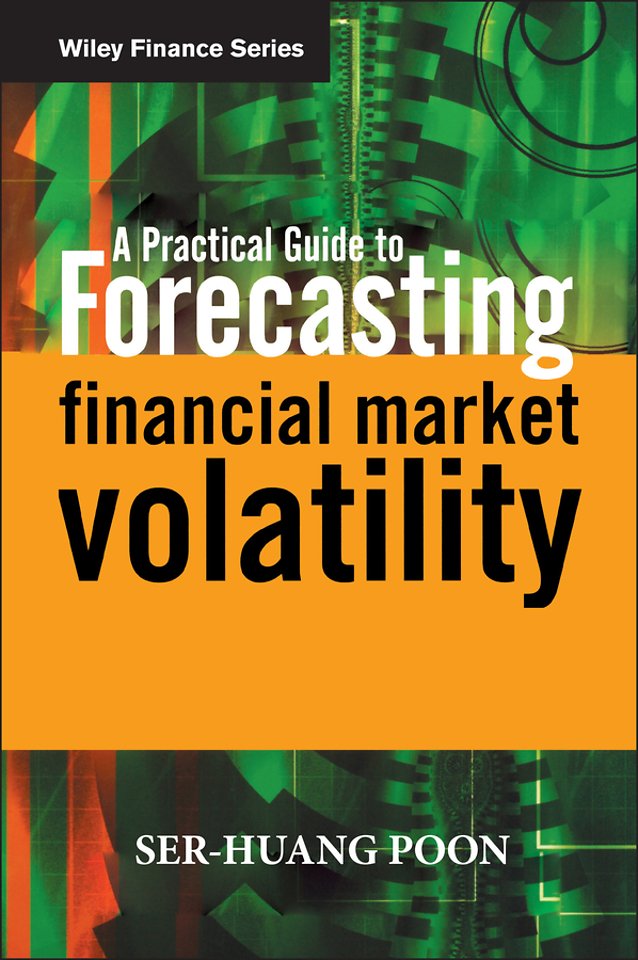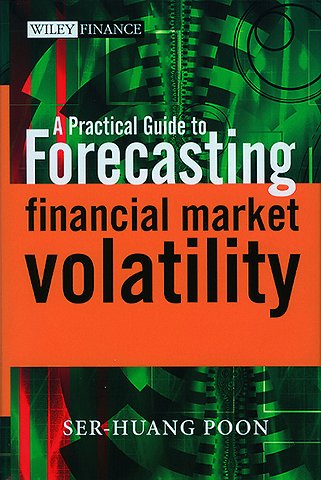Ser-Huang Poon
A Practical Guide to Forecasting Financial Market Volatility
Gebonden Engels 2005 1e druk 9780470856130Levertijd ongeveer 8 werkdagen
Gratis verzonden
Specificaties
ISBN13:9780470856130
Trefwoorden:toekomst, financiële markten
Taal:Engels
Bindwijze:gebonden
Aantal pagina's:220
Uitgever:John Wiley & Sons
Druk:1
Hoofdrubriek:Financieel management
Lezersrecensies
Wees de eerste die een lezersrecensie schrijft!
Inhoudsopgave
Foreword by Clive Granger.
Preface.
1 Volatility Definition and Estimation.
1.1 What is volatility?
1.2 Financial market stylized facts.
1.3 Volatility estimation.
1.3.1 Using squared return as a proxy for daily volatility.
1.3.2 Using the high low measure to proxy volatility.
1.3.3 Realized volatility, quadratic variation and jumps.
1.3.4 Scaling and actual volatility.
1.4 The treatment of large numbers.
2 Volatility Forecast Evaluation.
2.1 The form of X<sub>t</sub>.
2.2 Error statistics and the form of <sub>t</sub>.
2.3 Comparing forecast errors of different models.
2.3.1 Diebold and Mariano's asymptotic test.
2.3.2 Diebold and Mariano's sign test.
2.3.3 Diebold and Mariano'sWilcoxon sign-rank test.
2.3.4 Serially correlated loss differentials.
2.4 Regression-based forecast efficiency and orthogonality test.
2.5 Other issues in forecast evaluation.
3 Historical Volatility Models.
3.1 Modelling issues.
3.2 Types of historical volatility models.
3.2.1 Single-state historical volatility models.
3.2.2 Regime switching and transition exponential smoothing.
3.3 Forecasting performance.
4 Arch.
4.1 Engle (1982).
4.2 Generalized ARCH.
4.3 Integrated GARCH.
4.4 Exponential GARCH.
4.5 Other forms of nonlinearity.
4.6 Forecasting performance.
5 Linear and Nonlinear Long Memory Models.
5.1 What is long memory in volatility?
5.2 Evidence and impact of volatility long memory.
5.3 Fractionally integrated model.
5.3.1 FIGARCH.
5.3.2 FIEGARCH.
5.3.3 The positive drift in fractional integrated series.
5.3.4 Forecasting performance.
5.4 Competing models for volatility long memory.
5.4.1 Breaks.
5.4.2 Components model.
5.4.3 Regime-switching model.
5.4.4 Forecasting performance.
6 Stochastic Volatility.
6.1 The volatility innovation.
6.2 The MCMC approach.
6.2.1 The volatility vector H.
6.2.2 The parameter w.
6.3 Forecasting performance.
7 Multivariate Volatility Models.
7.1 Asymmetric dynamic covariance model.
7.2 A bivariate example.
7.3 Applications.
8 Black-Scholes.
8.1 The Black-Scholes formula.
8.1.1 The Black-Scholes assumptions.
8.1.2 Black-Scholes implied volatility.
8.1.3 Black-Scholes implied volatility smile.
8.1.4 Explanations for the 'smile'.
8.2 Black-Scholes and no-arbitrage pricing.
8.2.1 The stock price dynamics.
8.2.2 The Black-Scholes partial differential equation.
8.2.3 Solving the partial differential equation.
8.3 Binomial method.
8.3.1 Matching volatility with u and d.
8.3.2 A two-step binomial tree and American-style options.
8.4 Testing option pricing model in practice.
8.5 Dividend and early exercise premium.
8.5.1 Known and finite dividends.
8.5.2 Dividend yield method.
8.5.3 Barone-Adesi and Whaley quadratic approximation.
8.6 Measurement errors and bias.
8.6.1 Investor risk preference.
8.7 Appendix: Implementing Barone-Adesi and Whaley's efficient algorithm.
9 Option Pricing with Stochastic Volatility.
9.1 The Heston stochastic volatility option pricing model.
9.2 Heston price and Black-Scholes implied.
9.3 Model assessment.
9.3.1 Zero correlation.
9.3.2 Nonzero correlation.
9.4 Volatility forecast using the Heston model.
9.5 Appendix: The market price of volatility risk.
9.5.1 Ito's lemma for two stochastic variables.
9.5.2 The case of stochastic volatility.
9.5.3 Constructing the risk-free strategy.
9.5.4 Correlated processes.
9.5.5 The market price of risk.
10 Option Forecasting Power.
10.1 Using option implied standard deviation to forecast volatility.
10.2 At-the-money or weighted implied?
10.3 Implied biasedness.
10.4 Volatility risk premium.
11 Volatility Forecasting Records.
11.1 Which volatility forecasting model?
11.2 Getting the right conditional variance and forecast with the 'wrong' models.
11.3 Predictability across different assets.
11.3.1 Individual stocks.
11.3.2 Stock market index.
11.3.3 Exchange rate.
11.3.4 Other assets.
12 Volatility Models in Risk Management.
12.1 Basel Committee and Basel Accords I & II.
12.2 VaR and backtest.
12.2.1 VaR.
12.2.2 Backtest.
12.2.3 The three-zone approach to backtest evaluation.
12.3 Extreme value theory and VaR estimation.
12.3.1 The model.
12.3.2 10-day VaR.
12.3.3 Multivariate analysis.
12.4 Evaluation of VaR models.
13 VIX and Recent Changes in VIX.
13.1 New definition for VIX.
13.2 What is the VXO?
13.3 Reason for the change.
14 Where Next?
Appendix.
References.
Index.
Preface.
1 Volatility Definition and Estimation.
1.1 What is volatility?
1.2 Financial market stylized facts.
1.3 Volatility estimation.
1.3.1 Using squared return as a proxy for daily volatility.
1.3.2 Using the high low measure to proxy volatility.
1.3.3 Realized volatility, quadratic variation and jumps.
1.3.4 Scaling and actual volatility.
1.4 The treatment of large numbers.
2 Volatility Forecast Evaluation.
2.1 The form of X<sub>t</sub>.
2.2 Error statistics and the form of <sub>t</sub>.
2.3 Comparing forecast errors of different models.
2.3.1 Diebold and Mariano's asymptotic test.
2.3.2 Diebold and Mariano's sign test.
2.3.3 Diebold and Mariano'sWilcoxon sign-rank test.
2.3.4 Serially correlated loss differentials.
2.4 Regression-based forecast efficiency and orthogonality test.
2.5 Other issues in forecast evaluation.
3 Historical Volatility Models.
3.1 Modelling issues.
3.2 Types of historical volatility models.
3.2.1 Single-state historical volatility models.
3.2.2 Regime switching and transition exponential smoothing.
3.3 Forecasting performance.
4 Arch.
4.1 Engle (1982).
4.2 Generalized ARCH.
4.3 Integrated GARCH.
4.4 Exponential GARCH.
4.5 Other forms of nonlinearity.
4.6 Forecasting performance.
5 Linear and Nonlinear Long Memory Models.
5.1 What is long memory in volatility?
5.2 Evidence and impact of volatility long memory.
5.3 Fractionally integrated model.
5.3.1 FIGARCH.
5.3.2 FIEGARCH.
5.3.3 The positive drift in fractional integrated series.
5.3.4 Forecasting performance.
5.4 Competing models for volatility long memory.
5.4.1 Breaks.
5.4.2 Components model.
5.4.3 Regime-switching model.
5.4.4 Forecasting performance.
6 Stochastic Volatility.
6.1 The volatility innovation.
6.2 The MCMC approach.
6.2.1 The volatility vector H.
6.2.2 The parameter w.
6.3 Forecasting performance.
7 Multivariate Volatility Models.
7.1 Asymmetric dynamic covariance model.
7.2 A bivariate example.
7.3 Applications.
8 Black-Scholes.
8.1 The Black-Scholes formula.
8.1.1 The Black-Scholes assumptions.
8.1.2 Black-Scholes implied volatility.
8.1.3 Black-Scholes implied volatility smile.
8.1.4 Explanations for the 'smile'.
8.2 Black-Scholes and no-arbitrage pricing.
8.2.1 The stock price dynamics.
8.2.2 The Black-Scholes partial differential equation.
8.2.3 Solving the partial differential equation.
8.3 Binomial method.
8.3.1 Matching volatility with u and d.
8.3.2 A two-step binomial tree and American-style options.
8.4 Testing option pricing model in practice.
8.5 Dividend and early exercise premium.
8.5.1 Known and finite dividends.
8.5.2 Dividend yield method.
8.5.3 Barone-Adesi and Whaley quadratic approximation.
8.6 Measurement errors and bias.
8.6.1 Investor risk preference.
8.7 Appendix: Implementing Barone-Adesi and Whaley's efficient algorithm.
9 Option Pricing with Stochastic Volatility.
9.1 The Heston stochastic volatility option pricing model.
9.2 Heston price and Black-Scholes implied.
9.3 Model assessment.
9.3.1 Zero correlation.
9.3.2 Nonzero correlation.
9.4 Volatility forecast using the Heston model.
9.5 Appendix: The market price of volatility risk.
9.5.1 Ito's lemma for two stochastic variables.
9.5.2 The case of stochastic volatility.
9.5.3 Constructing the risk-free strategy.
9.5.4 Correlated processes.
9.5.5 The market price of risk.
10 Option Forecasting Power.
10.1 Using option implied standard deviation to forecast volatility.
10.2 At-the-money or weighted implied?
10.3 Implied biasedness.
10.4 Volatility risk premium.
11 Volatility Forecasting Records.
11.1 Which volatility forecasting model?
11.2 Getting the right conditional variance and forecast with the 'wrong' models.
11.3 Predictability across different assets.
11.3.1 Individual stocks.
11.3.2 Stock market index.
11.3.3 Exchange rate.
11.3.4 Other assets.
12 Volatility Models in Risk Management.
12.1 Basel Committee and Basel Accords I & II.
12.2 VaR and backtest.
12.2.1 VaR.
12.2.2 Backtest.
12.2.3 The three-zone approach to backtest evaluation.
12.3 Extreme value theory and VaR estimation.
12.3.1 The model.
12.3.2 10-day VaR.
12.3.3 Multivariate analysis.
12.4 Evaluation of VaR models.
13 VIX and Recent Changes in VIX.
13.1 New definition for VIX.
13.2 What is the VXO?
13.3 Reason for the change.
14 Where Next?
Appendix.
References.
Index.
Anderen die dit boek kochten, kochten ook
Rubrieken
- advisering
- algemeen management
- coaching en trainen
- communicatie en media
- economie
- financieel management
- inkoop en logistiek
- internet en social media
- it-management / ict
- juridisch
- leiderschap
- marketing
- mens en maatschappij
- non-profit
- ondernemen
- organisatiekunde
- personal finance
- personeelsmanagement
- persoonlijke effectiviteit
- projectmanagement
- psychologie
- reclame en verkoop
- strategisch management
- verandermanagement
- werk en loopbaan









